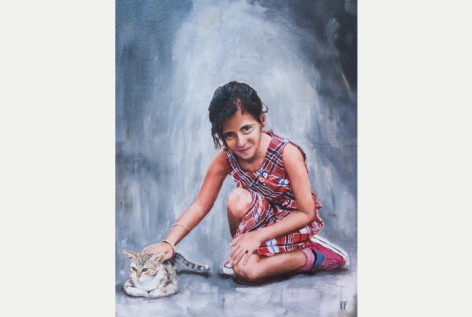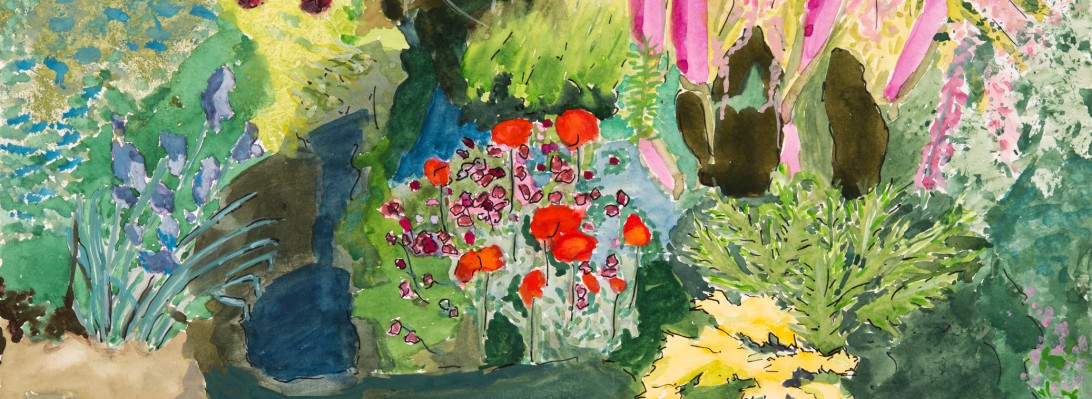
I recently went to see a remarkable exhibition at St. Michaels Without church in Bath. In mediaeval times it was the first church outside the city walls when going out of the North Gate, hence its name. Now, in the centre of Bath, it is a light, airy church, with tall slim pillars. The pews have been replaced with chairs and there is a feeling of spaciousness.
The exhibition was designed to raise awareness of the plight of the refugees, and for me it did exactly that. The first thing I saw on going in was a large table covered with crocheted hearts in different colours and sizes. I was invited to choose a heart and then to thread it through the metal fencing on which were hung portraits of refugees, on either side of the central aisle leading down to the altar.
I chose a dark pink heart. There was a safety pin attached to the end piece of wool and scissors were there to snip it off, so I could pin it onto my jacket. With my heart, now loosely unravelling, I walked down the aisle, threading my heart in and out of the fencing and looking at the portraits of the refugees, men, women and children, which had been skilfully painted by the artist Penny Faux, from photos provided by the UNHR Council. By each portrait there was a record of that refugee’s story, many of them already known to us. As I walked along, looking and reading, and saw the multi-coloured threads of wool running zigzag up and down the fencing – two tents had been placed on either side outside the perimeter fencing – I found the symbolism deeply moving.


The whole exhibition, put together in such an imaginative way, was created by two women, one a painter, the other an installation artist. As Penny said: “It’s to keep people aware of the crisis and the need to help others. These are not masses of people who we should be frightened of.”

Following on my visit to the exhibition I saw that our local Tory MP was going to have a surgery in my village. I am not a political animal, though I am a humanitarian one, and I have never done such a thing in my life before, but I went to see him.
He was a very nice young man, with nice eyes behind his glasses. An old friend of mine used to say of all politicians – does he have a human face?
My visit was very timely, he said, as they were just in the process of negotiations with the French government. I mentioned the unaccompanied children in the ‘Jungle’ in Calais, with relatives in Britain. They were trying to trace and identify all these children, he said. Some of them were only two and three years old, and only knew their name. It could take months to trace them all.
My heart sank. What could happen to these young children in that space of time? I did receive a long and comprehensive letter from my MP. With the best of intentions, it did little to reassure me. The wheels of bureaucracy grind exceedingly slow.
I have been listening to John le Carré reading extracts from his fascinating memoir on Radio 4.
In 1974 he went to Cambodia with a journalist friend. There he found himself in the thick of combat, and he soon realised he was not a brave man. One of the bravest people he had ever met, he said, was Yvette Pierpaoli. He described her as a ‘small, sparky, tough, provincial Frenchwoman.’ With her partner, she ran a business selling small planes, tractors and chemicals. By 1974 a large number of refugees were pouring into Phnom Penh, fleeing the advance of the Khmer Rouge. She was moved by their plight, and spent much of her time helping the refugee children. She had no scruples when trying to get cash from people whose money, she considered, would be better off in the hands of the needy.
There is a story that she decided to take a number of children to France, and went to the French Consulate to obtain passports. The official asked who was their mother. “They are all mine” she declared. He looked astonished at so many children around the same age. “Yes, they are all quadruplets”, she declared. She got her passports!
She returned to France and continued her humanitarian work. She demonstrated that a single person can sometimes achieve what large organisations cannot. She said “people assumed that a project had to have ideas, personnel and materials and funds. In my mind, things happened in the opposite way …”
In 1992 she published her autobiography Woman of a Thousand Children. She also became European Representative of Refugees International. In 1999 she was killed in a car crash whilst on a mission to assist refugees from Kosovo.
Le Carré said he based his book The Constant Gardener, later made into a film, on her character.
Perhaps we need more people like Yvette Pierpaoli around today, people who can cut through the red tape and get things done.





Thank you, Daphne for continuing to shed light on this hesrtbreaking situation.
LikeLike
Thanks Susan, you are always so supportive.
LikeLike